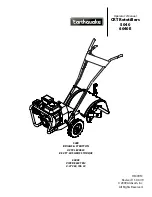
30
4.
Using a distortion analyzer and an oscilloscope, turn the bias trim pot (VR1) CCW
until distortion spikes disappear, and the THD+N reading is below 0.1%.
5.
Turn oscillator off, while keeping the amplifier on.
6.
Verify the power is between 10 and 20 watts.
K) High Frequency Power Amp Test
Turn off Generator A.
1.
Amp pulls excessive power when board is powered.
If the output of the amplifier, pin 3 of U1, is centered (around ground potential) check for
a short from ground to the output pin, pin 3 of U1. If no shorting problem is found replace
U1.
If the output pin, pin 3, is offset to one of the rails the power consumption should go to
normal idle level (less than 20W) if the 8 ohm load is removed. If it does not, check for
shorting from the output pin, pin 3, to either the +39V or –39V supplies. If not shorted
replace U1.
If the output is offset, and the power consumption goes down to normal with the load re-
moved, check the following:
Verify that the input to the amp, pin 10, is close to ground potential. If not close, check for
shorts surrounding pin 10. If no shorts are found replace U1.
Verify that pin 9 reflects the output offset polarity. The offset should be much greater than
+/– 1V. If not look for shorts surrounding pin 9 and verify values of R38, R40 and C25. If
no problem found replace U1.
2.
No output from the amp when driven.
Verify input to the amp on pin 10. If no signal is present verify that there is a signal at pin 7
of U2. If signal is present a pin 7 of U2 verify values of C27, R51, R50 and R39. Look for
shorts at pin 10 of U1 and for shorts at pin 7 of P3. If nothing is found in above testing
replace U1.
The amp should be out of muting. Verify that pin 8 is equal to about –3V. If the muting pin
is substantially lower, replace U1. If the voltage goes higher than around –5V, and the turn
on delay is operating properly (junction of R44 D15 at around –15V), replace U1.
3.
Is the gain of the amplifier low or high? (The gain should be equal to 21). The gain from
pin 10 to pin 3 should be around 21.
4.
Does the amp oscillate? Verify correct values of R37, C24, C20, R28, C19, and C22. If
all this is OK replace U1.
5.
Is output distorted? Verify input to amp, pin 10 is clean. If input is OK replace U1.
Summary of Contents for EON15
Page 23: ...High Frequency Response EON Power15 and EON15P 1 230 33...
Page 24: ...Low Frequency Response EON Power15 and EON15P 1 230 34...
Page 30: ...Low Frequency Response EON PowerSub 40...
Page 35: ...High Frequency Response EON Power10 45...
















































